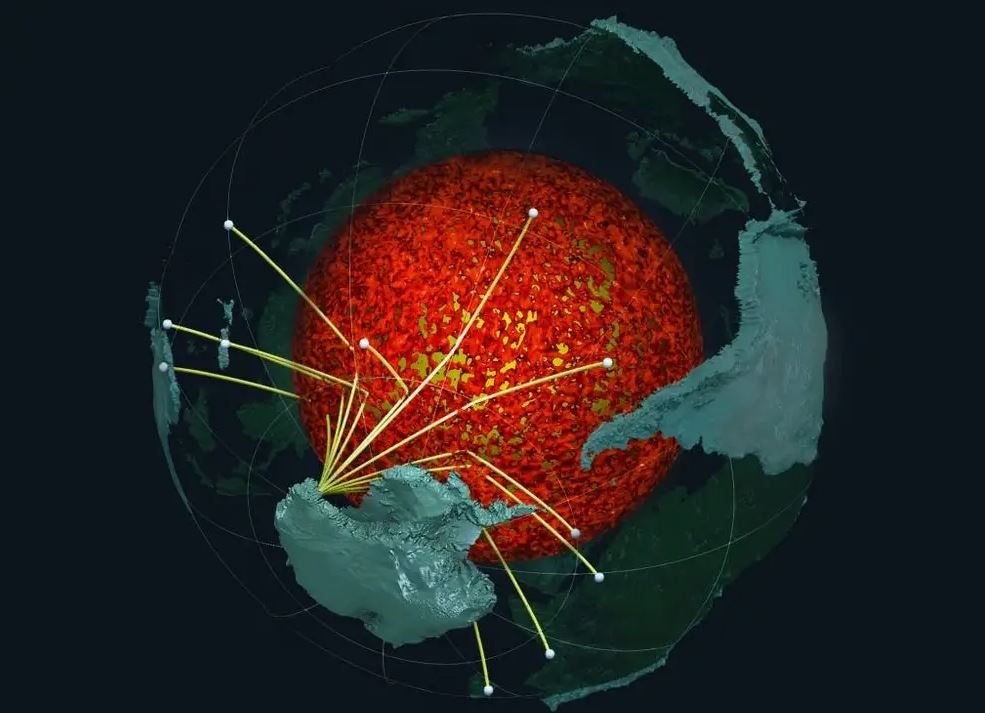

An artistic impression inspired by scientists’ discovery that a structure made of ancient ocean could wrap around the Earth’s core, protecting the mantle from its intense heat. Edward Garnero and Mingming Li at Arizona State University
There’s still a lot we don’t know about the core of our planet, which lies roughly 1,800 miles beneath our feet. Now, a new study can help researchers shed light on its mysterious inner workings. The research indicates that the Earth’s core could be covered by an ancient ocean floor that includes giant mountains five times the size of Mount Everest.
The researchers made this discovery after creating the most detailed map of the geology under the southern hemisphere of our planet.
If confirmed, this is a “recycled” ocean floor. It will act almost like a “blanket” keeping the heat trapped inside the coreSamantha Hansen, lead author of the study and a professor of geosciences at the University of Alabama, told Insider.
The Earth is like a giant recycling plant
Scientists have long puzzled over the boundary between the mantle and the core.
About 2,000 miles below the Earth’s surface, conditions change dramaticallyTemperatures rise dramatically and the rock composition changes suddenly from a solid rock mass in the mantle to iron clay inside the core.
To understand more about this limit, scientists looked at seismic waves that come from earthquakes. As these waves propagate from the epicenter into our planet, they provide information about the Earth’s interior.
“Admittedly, seismic data is probably not that interesting to most people. It’s a crazy line that changes over time. But this crazy line contains an amazing amount of information!’” Hansen told Insider.
Scientists had previously identified the so-called areas Ultra Low Speed Zones (ULVZ) – Areas where seismic waves slow down unexpectedly – near the core-mantle boundary. But they only found “spots” of this unknown structure.
Hansen and her team headed to Antarctica to see how far this ULVZ could reach. They installed seismic equipment at 15 stations on the continent and collected data for three years.
They found it ULVZ was more common than previously thought. In fact, it was present “over much of the Southern Hemisphere,” suggesting that this layer covers the entire core.
The layer may come from recycled pieces of ancient ocean floors
Hansen and her team used modeling to understand how this layer appeared.
For them the answer was clear: The layer was probably parts of the ancient ocean floorWhich fell over the centuries from the surface as tectonic plates expanded and collided with each other.
“As the results were compiled – both from seismic work and geodynamic models – it was very interesting to see the similarities betweenQ,” the scientist confirmed.
“Together, they make a compelling case for this Submerged oceanic material is the main source of ULVZssHe explained.
The ocean floor, because of its composition, is an ideal candidate for this layer, Hansen says. It is very dense, which means it is heavy enough to sink into the mantle. It is also likely to become more resistant to heat because it experiences intense pressure deep within the Earth.
This could explain why the changes observed at the core-mantle boundary are so sharp.
“With this extra layer covering the core, heat will not be able to escape as easily/quickly“, pointed out.
It is very important to understand how heat moves and escapes from the core. “Fluctuations in core temperature control” where we have mantle plumes“The lava lakes that form archipelagos like Hawaii, for example,” Hansen emphasized.
It also affects the Earth’s magnetic field, as the researcher repeated. Before we can add this new layer to the science textbooks, more research will be needed to rule out other explanations.
Some have suggested that the ULVZ could be due to another, completely unknown substance, created by unique chemical reactions that can occur at the border. Others believe that the strange seismic data seen at the border is due to a specific melting condition that we do not fully understand.
However, if Hansen’s team is right, this could provide a new chapter in the story of Earth’s formation.
“If ULVZs are associated with these subducted materials, they could help us better understand how the overall tectonic cycle works and how our planet evolved over time.”” he said characteristically. assets Posted In the scientific journal Science Advance in April.

“Avid problem solver. Extreme social media junkie. Beer buff. Coffee guru. Internet geek. Travel ninja.”





More Stories
Top 20 Most Played Games in June 2024
Play Age of Mythology: Retold Playtest starting today!
Impressive Maniskin Concert in Greece